Charles E W Bean, Diaries, AWM38 3DRL 606/252/1 - 1918 - 1935 - Part 4
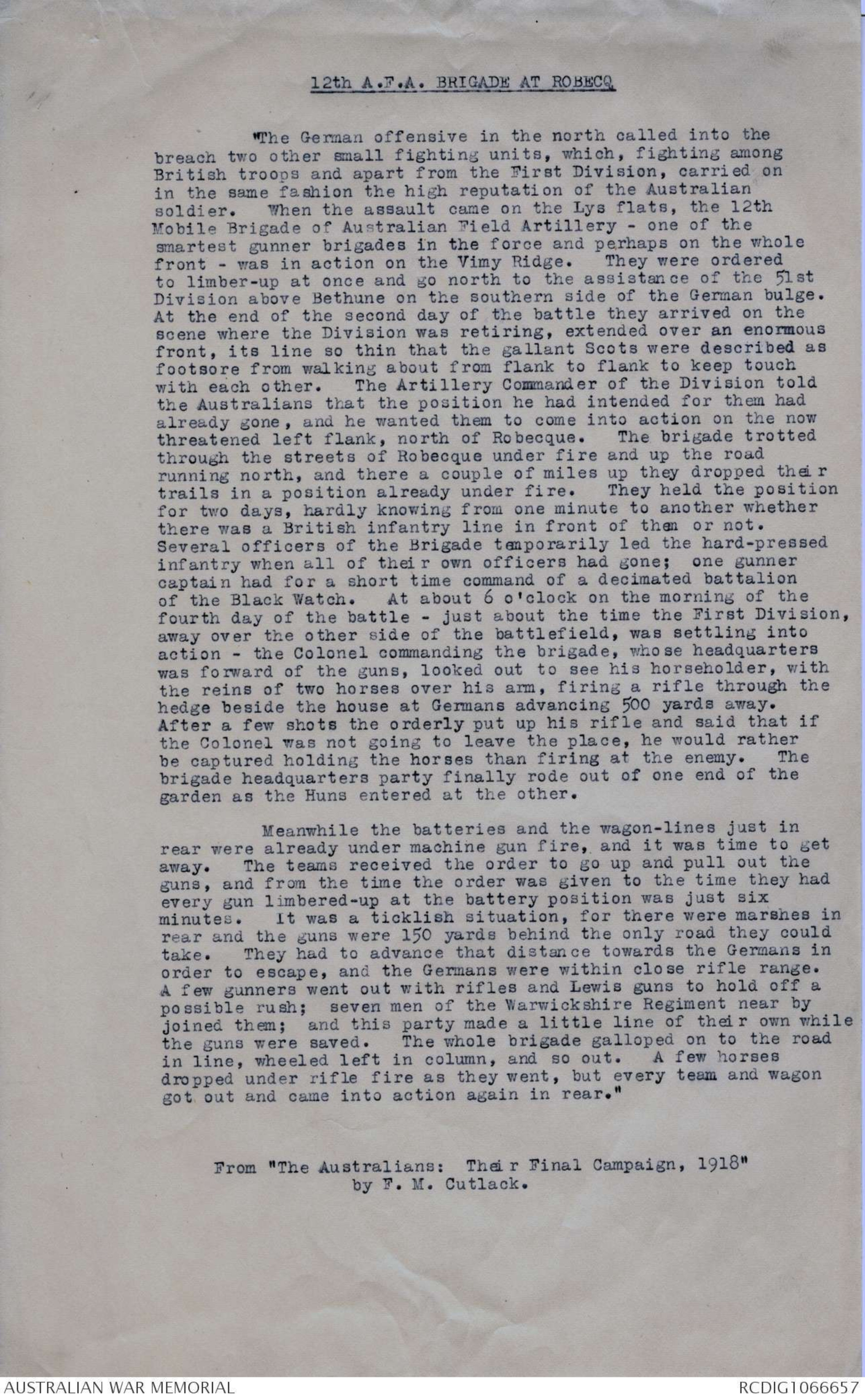
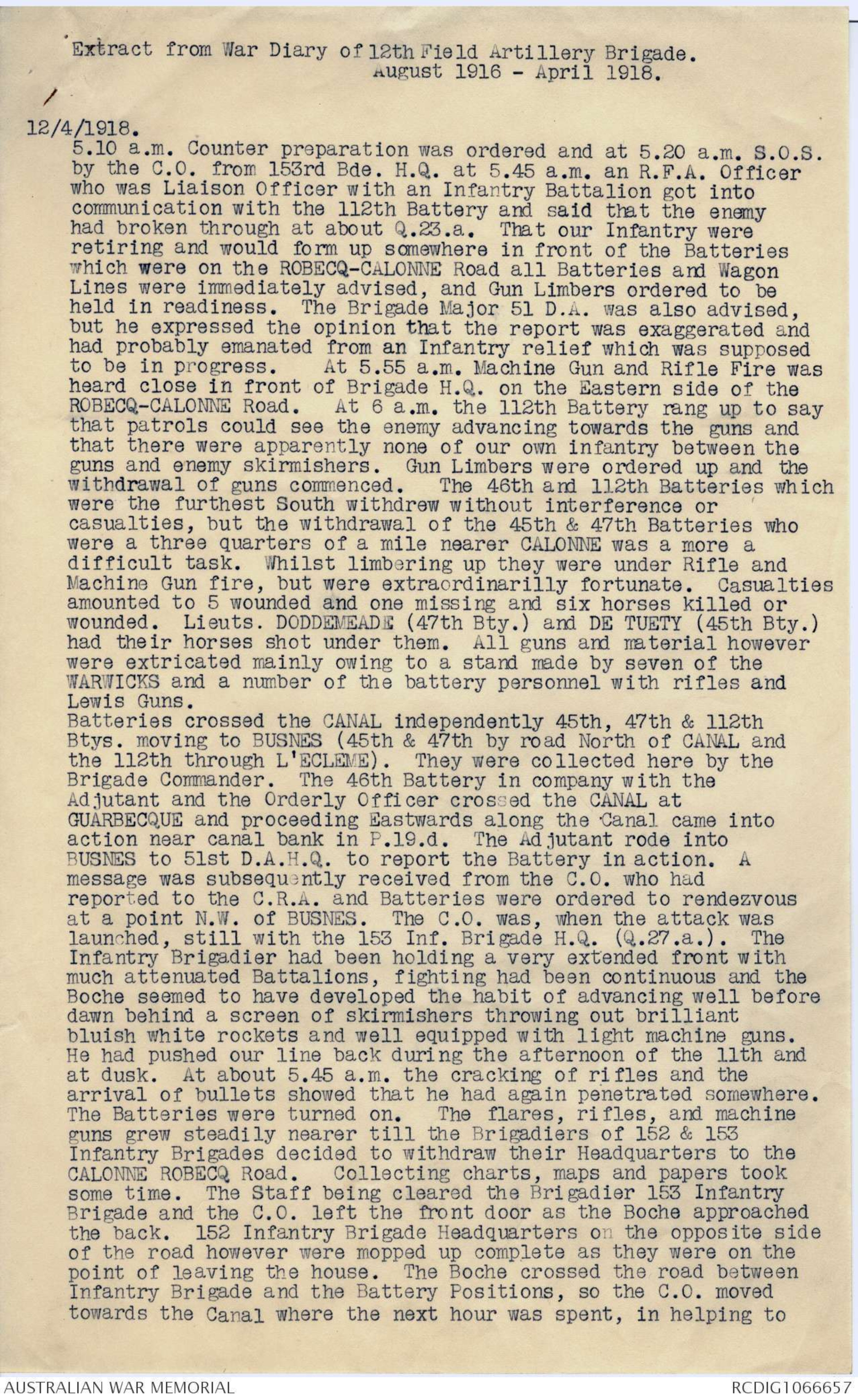
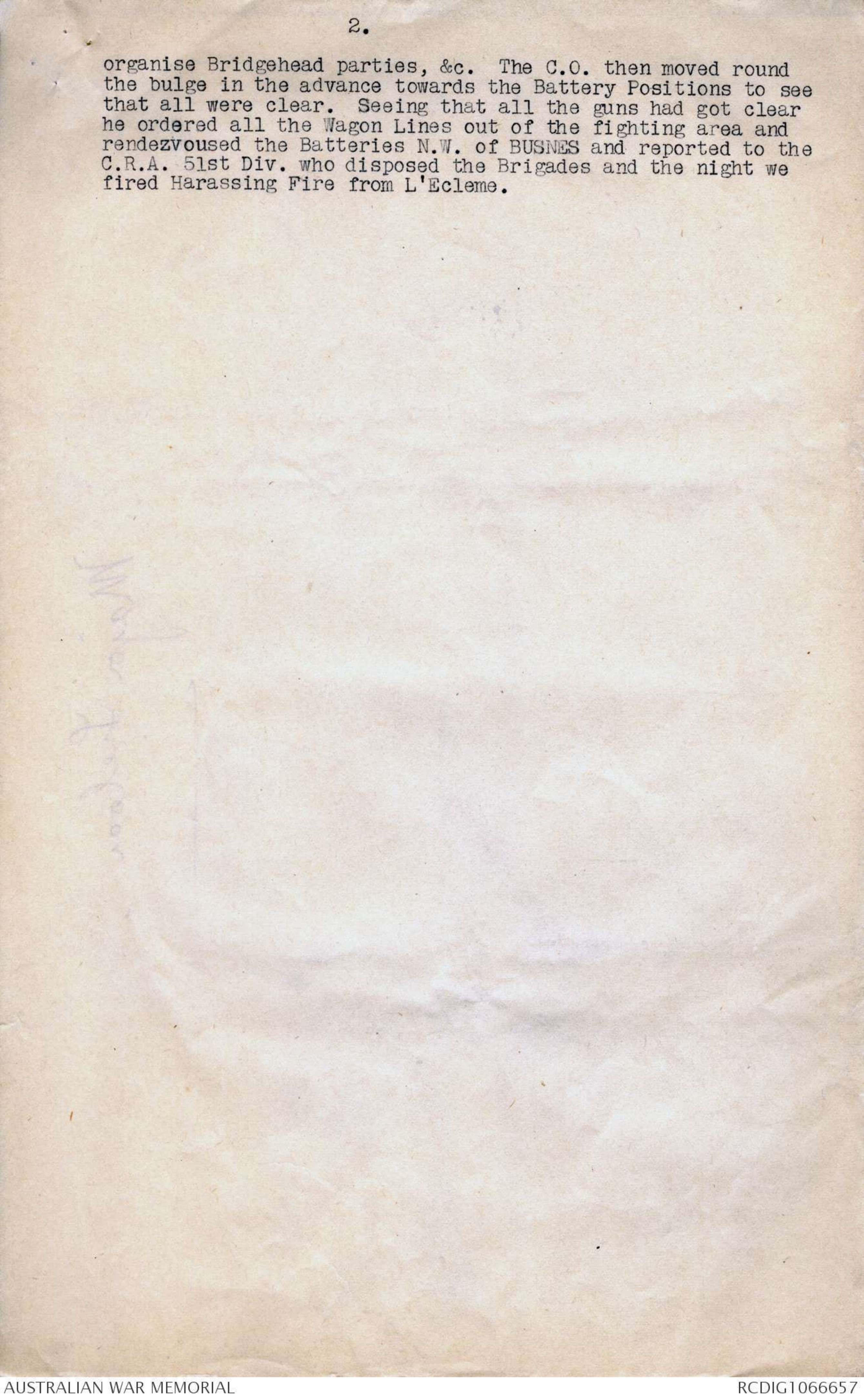
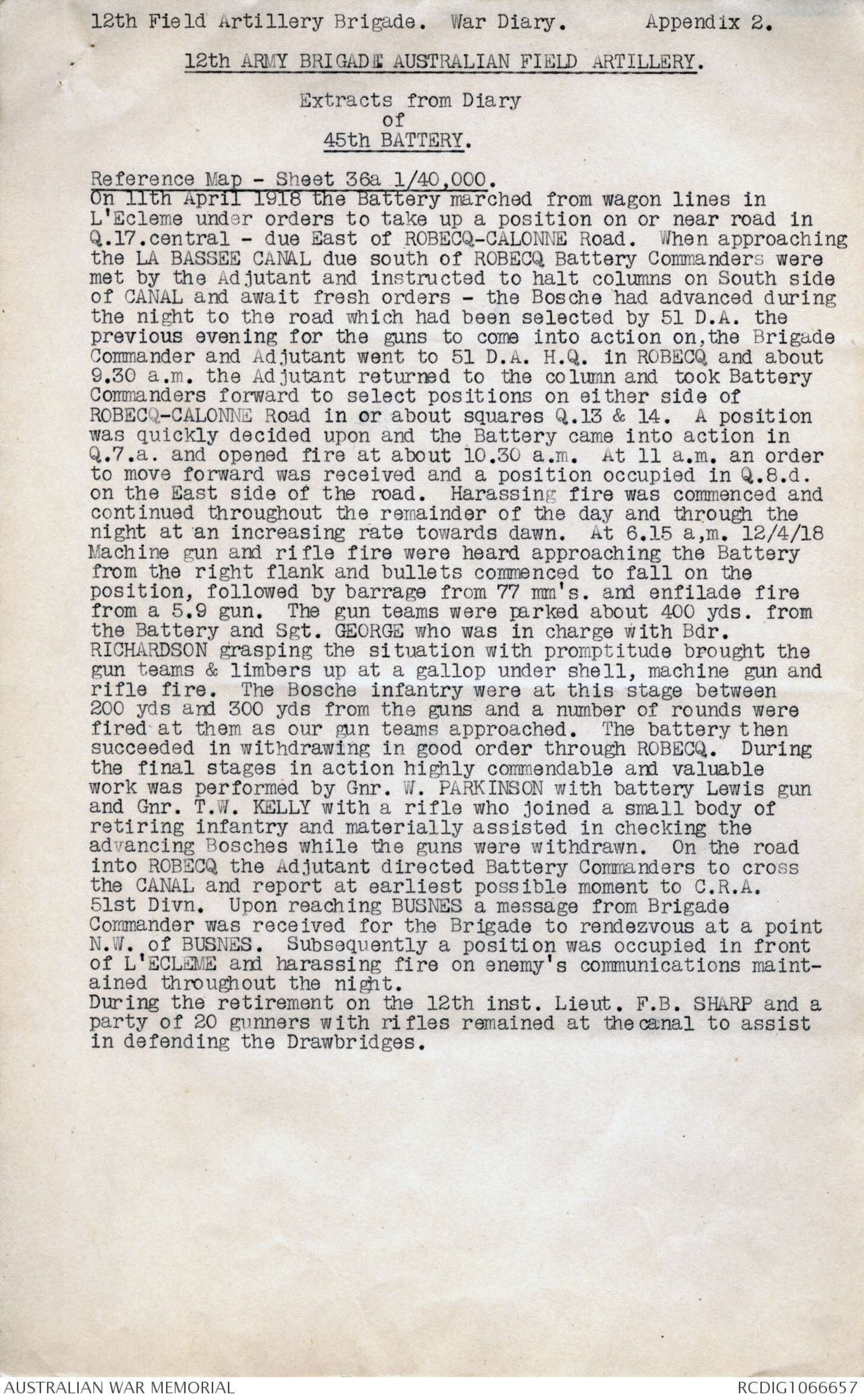
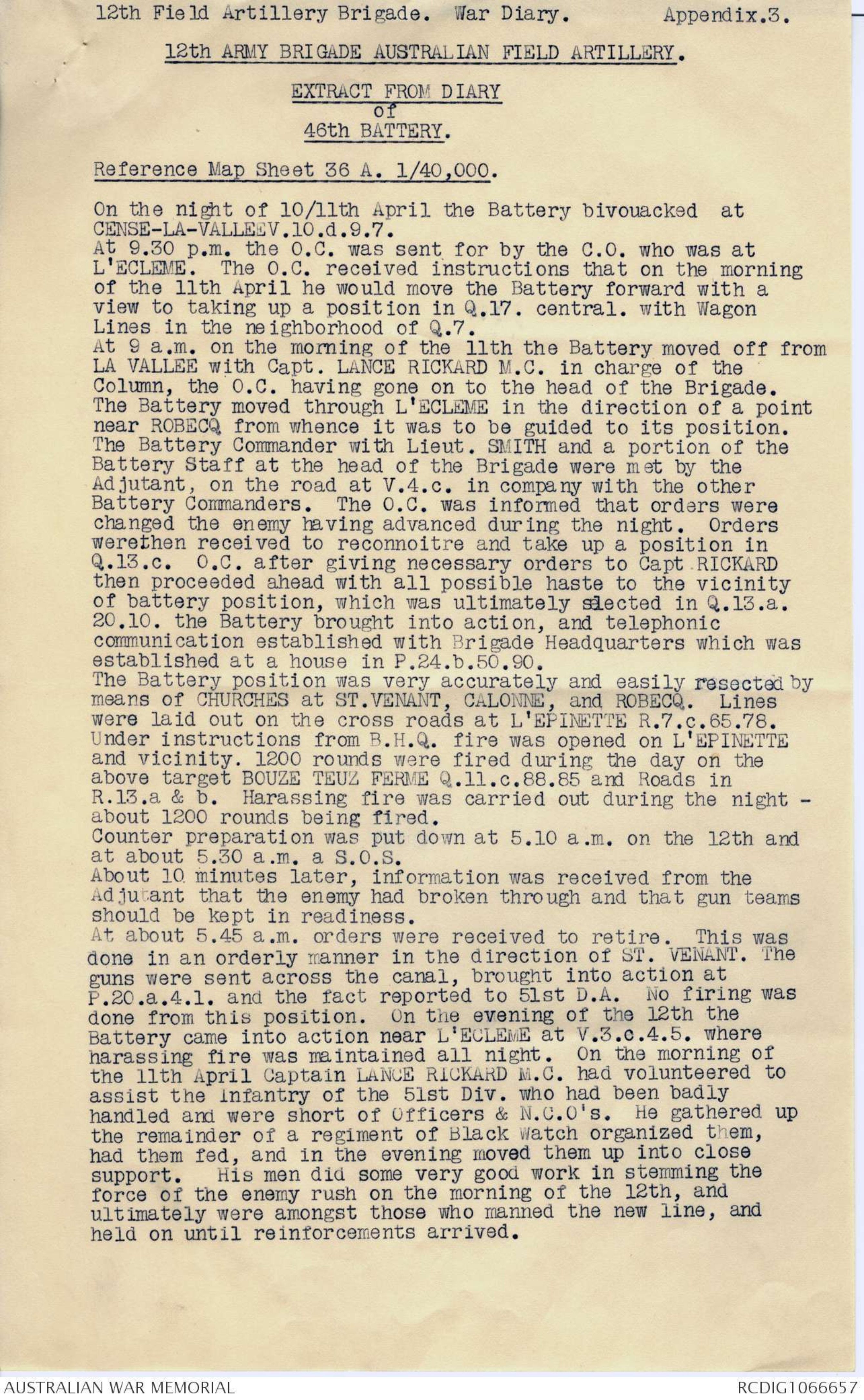
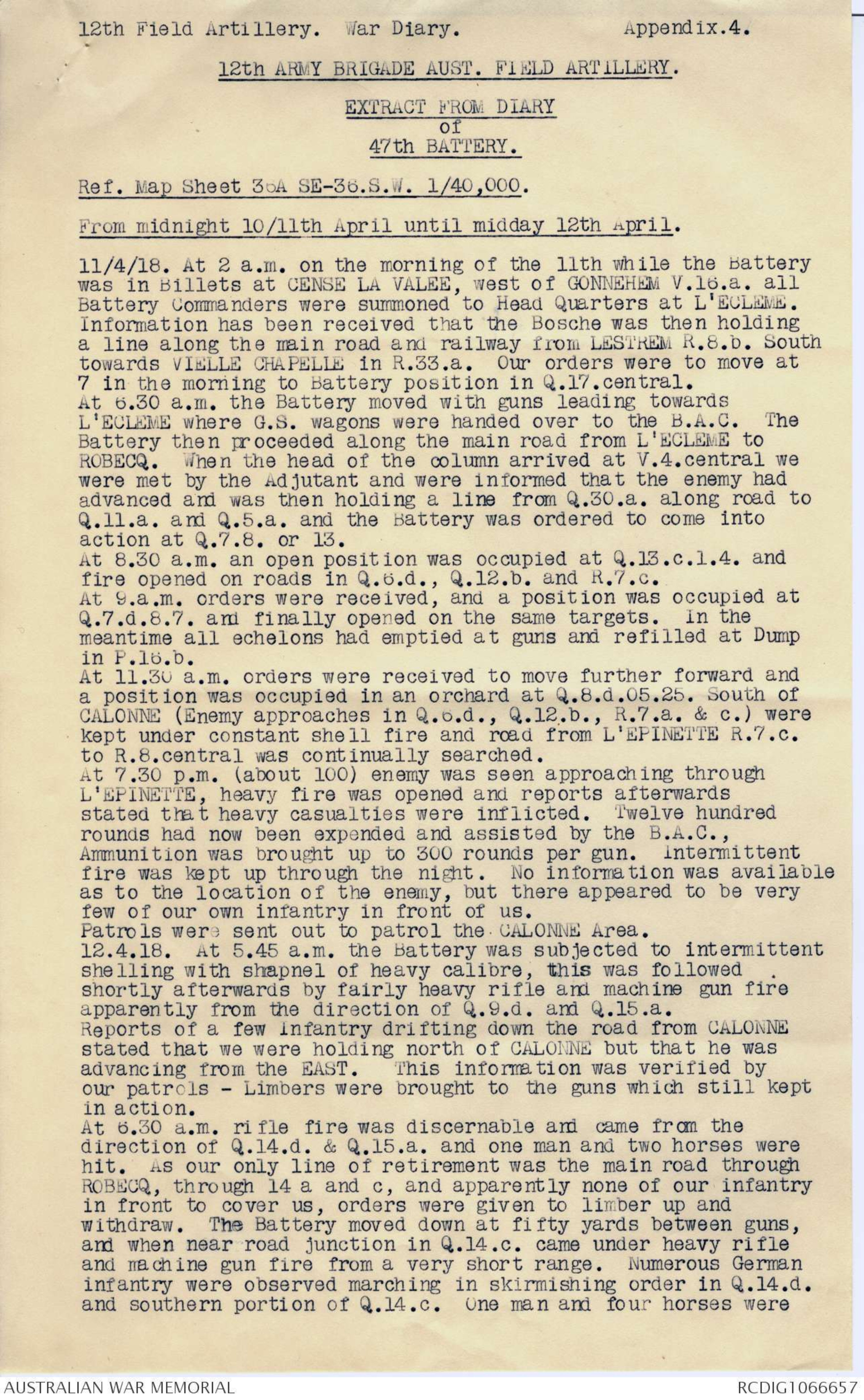
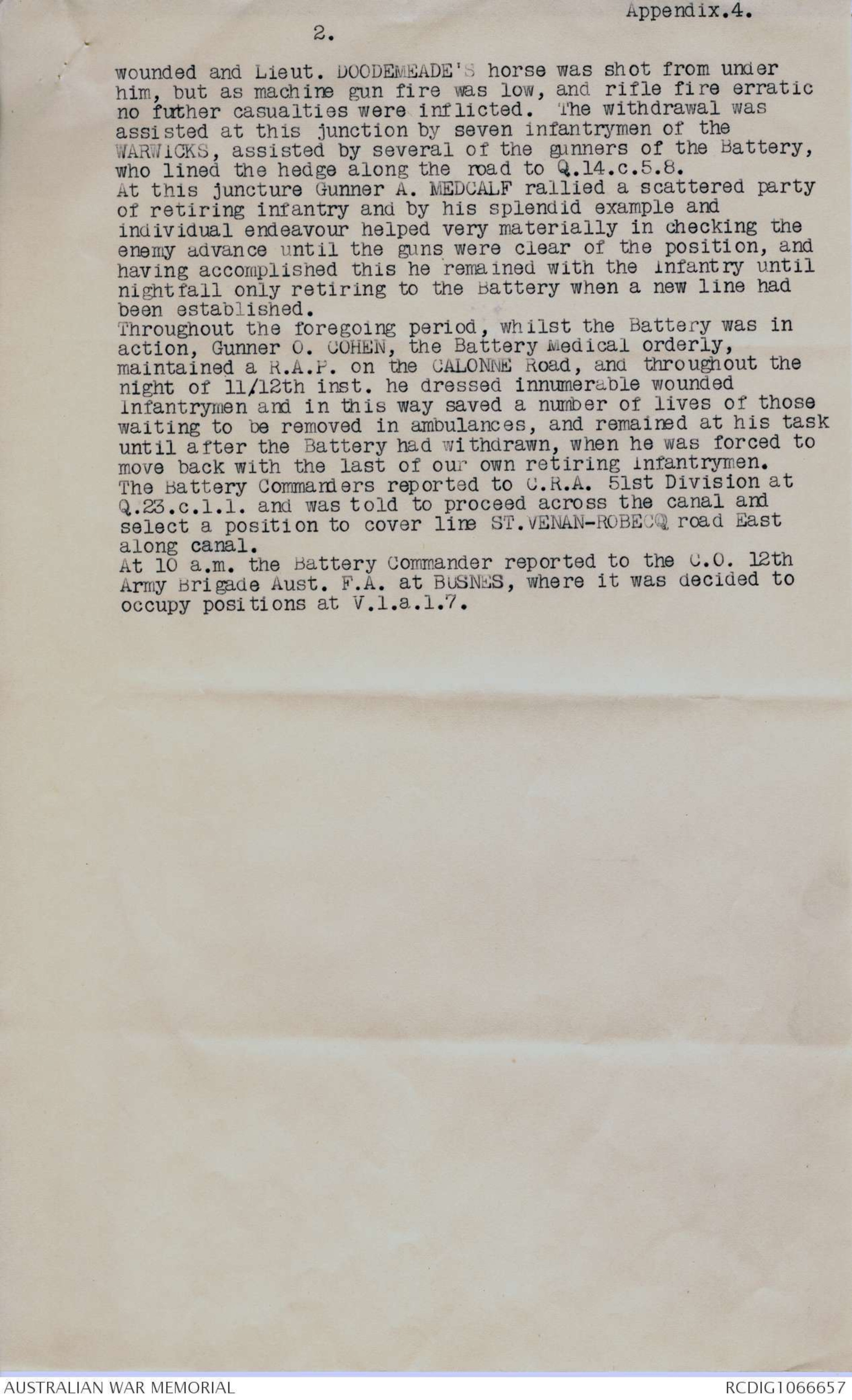
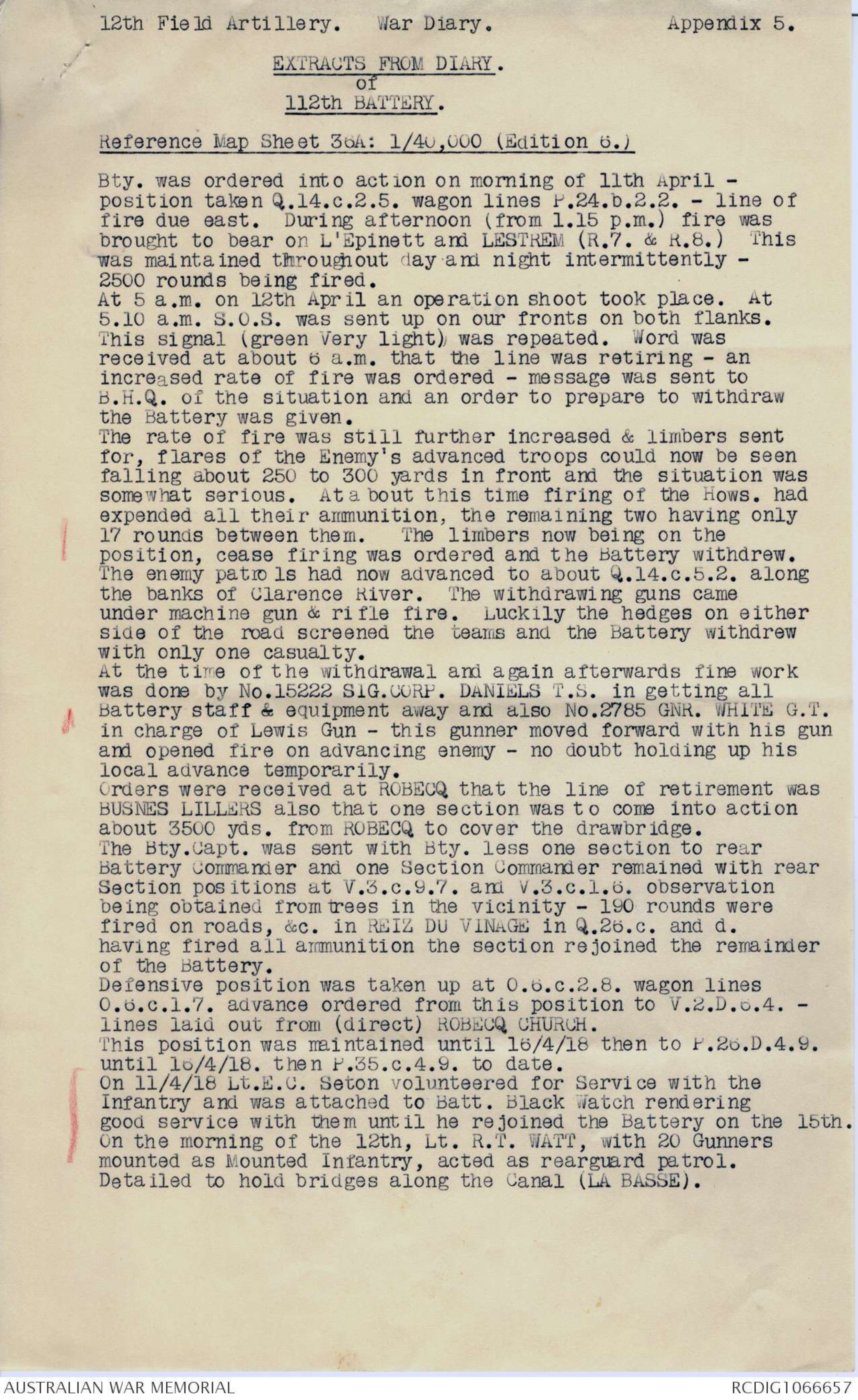
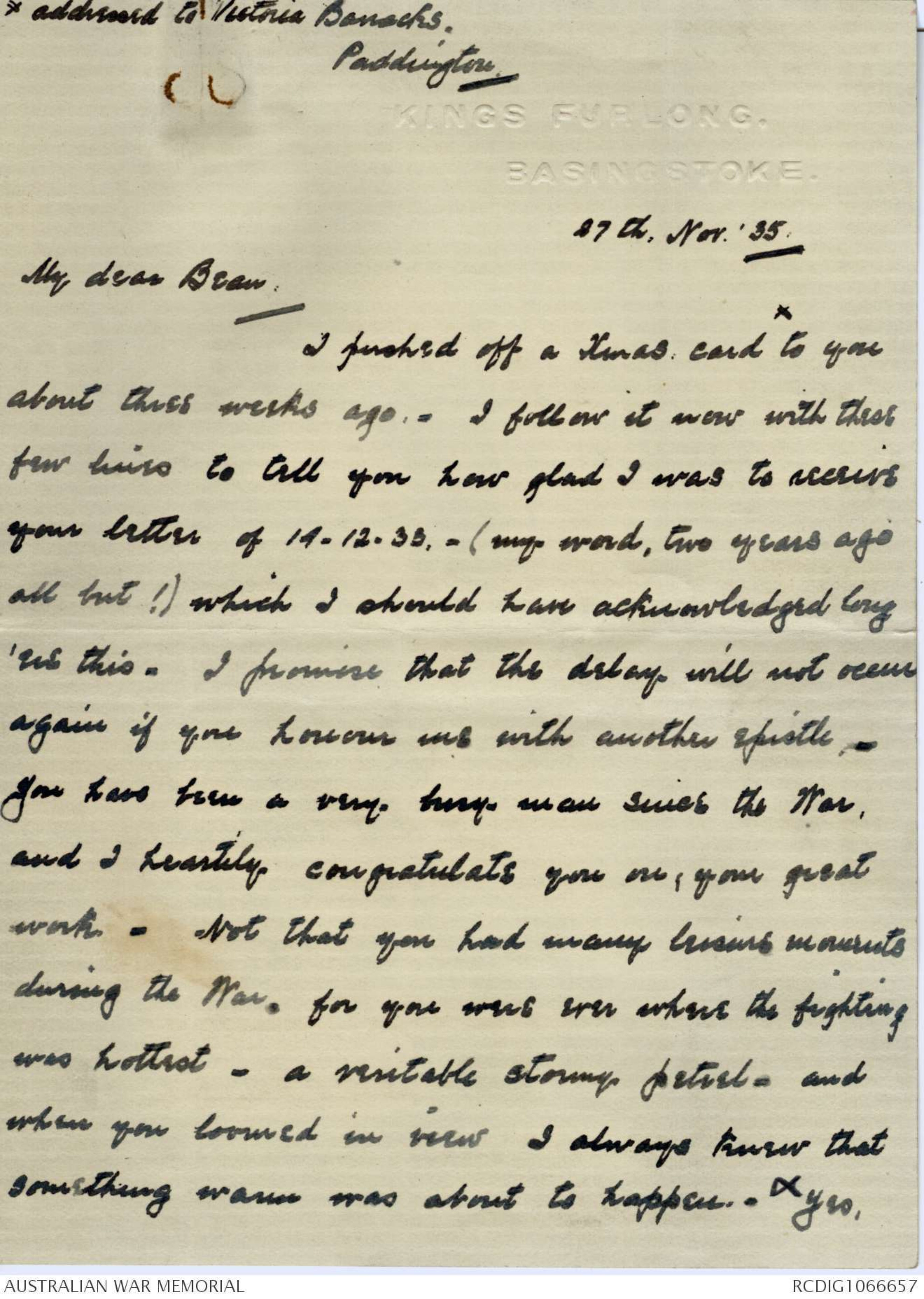
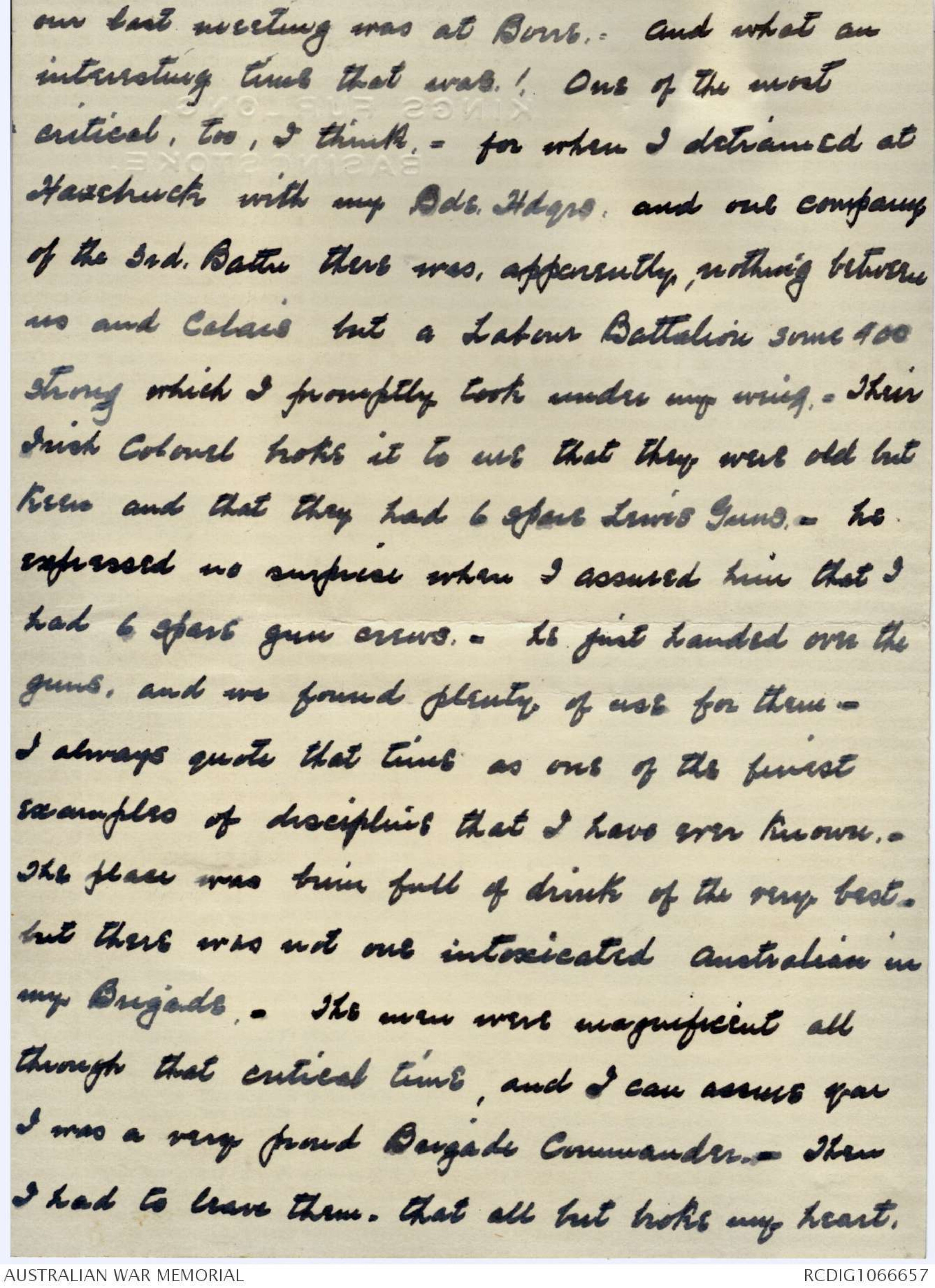
12th A.F.A. BRIGADE AT ROBECQ.
"The German offensive in the north called into the
breach two other small fighting units, which, fighting among
British troops and apart from the First Division, carried on
in the same fashion the high reputation of the Australian
soldier. When the assault came on the Lys flats, the 12th
Mobile Brigade of Australian Field Artillery - one of the
smartest gunner brigades in the force and perhaps on the whole
front - was in action on the Vimy Ridge. They were ordered
to limber-up at once and go north to the assistance of the 51st
Division above Bethune on the southern side of the German bulge.
At the end of the second day of the battle they arrived on the
scene where the Division was retiring, extended over an enormous
front, its line so thin that the gallant Scots were described as
footsore from walking about from flank to flank to keep touch
with each other. The Artillery Commander of the Division told
the Australians that the position he had intended for them has
already gone, and he wanted them to come into action on the
threatened left flank, north of Robecque. The brigade trotted
through the streets of Robecque under fire and up the road
running north, and there a couple of miles up they dropped their
trails in a position already under fire. They held the post
for two days, hardly knowing from one minute to the another whether
there was a British infantry line in front of them or not.
Several officers of the Brigade temporarily led the hard-pressed
infantry when all of their own officers had gone; one gunner
captain had for a short time command of a decimated battalion
of the Black Watch. At about 6 o'clock on the morning of the
fourth day of the battle - just about the time the First Division,
away over the other side of the battlefield, was settling into
action - the Colonel commanding the brigade, whose headquarters
was forward of the guns, looked out to see his horseholder, with
the reins of two horses over his arm, firing a rifle through the
hedge beside the house at Germans advancing 500 yards away.
After a few shots the orderly put up his rifle and said that if
the Colonel was not going to leave the place, he would rather
be captured holding horses than firing at the enemy. The
brigade headquarters party finally rode out of one end of the
garden as the Huns entered at the other.
Meanwhile the batteries and the wagon-lines just in the
rear were already under machine gun fire, and it was time to get
away. the teams received the order to go up and pull out the
guns, and from the time the order was given to the time they had
every gun limbered-up at the battery position was just six
minutes. It was a ticklish situation, for there were marshes in
rear and the guns were 150 yards behind the only road they could
take. They had to advance that distance towards the Germans in
order to escape, and the Germans were within close rifle range.
A few gunners went out with rifles and Lewis guns to hold off a
possible rush; seven men of the Warwickshire Regiment near by
joined them; and this party made a little line of their own while
the guns were saved. The whole brigade galloped on to the road
in line, wheeled left in column, and so out. A few horses
dropped under rifle fire as they went, but every team and wagon
got out and came into station again in rear."
From "The Australians: Their Final Campaign, 1918"
by F. M. Cutlack.
Extract from War Diary of 12th Field Artillery Brigade.
August 1916 - April 1918.
12/4/1918
5.10 a.m. Counter preparation was ordered and at 5.20 a.m. S.O.S.
by the C.O. from 153rd Bde. H.Q. at 5.45 a.m. an R.F.A. Officer
who was Liaison Officer with an Infantry Battalion got into
communication with the 112th Battery and said that the enemy
had broken through at about Q.23.a. That our Infantry were
retiring and would form up somewhere in front of the Batteries
which were on the ROBECQ-CALONNE Road all Batteries and Wagon
Lines were immediately advised, and Gun Limbers ordered to be
held in readiness. The Brigade Major 51 D.A. was also advised,
but he expressed the opinion that the report was exaggerated and
had probably emanated from an Infantry relief which was supposed
to be in progress. At 5.55 a.m. Machine Gun and Rifle Fire was
heard close to the front of Brigade H.Q. on the Eastern side of the
ROBECQ-CALONNE Road. At 6 a.m. the 112th Battery rang up to say
the patrols could see the enemy advancing towards the guns and
that there were apparently none of our own infantry between the
guns and enemy skirmishers. Gun Limbers were ordered up and the
withdrawal of guns commenced. The 46th and 112th Batteries which
were the furthest South withdrew without interference or
casualties, but the withdrawal of the 45th & 47th Batteries who
were a three quarters of a mile nearer CALONNE was a more a
different task. Whilst limbering up they were under Rifle and
Machine Gun fire, but were extraordinarily fortunate. Casualties
wounded. Lieuts. DODDEMEADE (47th Bty.) and DE TEUTY (45th Bty.)
had their horses shot under them. All guns and material however
were extricated mainly owing to a stand made by seven of the
WARWICKS and a number of the battery personnel with rifles and
Lewis Guns.
Batteries crossed the CANAL independently 45th, 47th & 112th
Btys. moving to BUSNES (45th & 47th by road North of CANAL and
the 112th through L'ECLEME). They were collected here by the
Brigade Commander. The 46th Battery in company with the
Adjutant and the Orderly Officer crossed the CANAL at
GUARBECQUE and proceeding Eastwards along the Canal came into
action near canal bank in P.19.d. The Adjutant road into
BUSNES to 51st D.A.H.Q. to report the Battery in action. A
message was subsequently received from the C.O. who had
reported to the C.R.A. and Batteries were ordered to rendezvous
at a point N.W. of BUSNES. The C.O. was, when the attack was
launched, still with the 153 Inf. Brigade H.Q. (Q.27.a.) The
Infantry Brigadier had been holding a very extended front with
much attenuated Battalions, fighting had been continuous and the
Boche seemed to have developed the habit of advancing well before
dawn behind a screen of skirmishers throwing out brilliant
bluish white rockets and well equipped with light machine guns.
He had pushed our line back during the afternoon of the 11th and
at dusk. At about 5.45 a.m. the cracking of rifles and the
arrival of bullets showed that he had again penetrated somewhere.
The Batteries were turned on. The flares, rifles, and machine
guns grew steadily nearer till the Brigadiers of 152 & 153
Infantry Brigades decided to withdraw their Headquarters to the
CALONNE ROBECQ Road. Collecting charts, maps and papers took
some time. The Staff being cleared the Brigadier 153 Infantry
Brigade and the C.O. left the front door as the Boche approached
the back. 152 Infantry Brigade Headquarters on the opposite side
of the road however were mopped up complete as they were on the
point of leaving the house. The Boche crossed the road between
Infantry Brigade and the Battery Positions, so the C.O. moved
towards the Canal where the next hour was spent, in helping to
2.
organise Bridgehead parties, &c. The C.O. then moved round
the bulge in the advance towards the Battery Positions to see
that all were clear. Seeing that all the guns had got clear
he ordered all the Wagon Lines out of the fighting area and
rendezvoused the Batteries N.W. of BUSNES and reported to the
C.R.A. 51st Div. who disposed the Brigades and the night we
fired Harassing Fire from L'Ecleme.
12th Field Artillery Brigade. War Diary. Appendix 2.
12th ARMY BRIGADE AUSTRALIAN FIELD ARTILLERY.
Extracts from Diary
of
45th BATTERY.
Reference Map - Sheet 36a 1/40,000.
On 11th April 1918 the Battery marched from wagon lines in
L'Ecleme under orders to take up a position on or near road in
Q17.central - due East of ROBECQ-CALONNE Road. When approaching
the LA BASSE CANAL due south of ROBECQ Battery Commanders were
met by the Adjutant and instructed to halt columns on South side
of CANAL and await fresh orders - the Bosche had advanced during
the night to the road which had been selected by 51 D.A. the
previous evening for the guns to come into action on, the Brigade
Commander and Adjutant went to 51 D.A. H.Q. in ROBECQ and about
9.30 a.m. the Adjutant returned to the column and took Battery
Commanders forward to select positions on either side of
ROBECQ-CALONNE Road in or about squares Q.13 & 14. A position
was quickly decided upon and the Battery came into action in
Q.7.a. and opened fire at about 10.30 a.m. At 11 a.m. an order
to move forward was received and a position occupied in Q.8.d.
on the East side of the road. Harassing fire was commenced and
continued throughout the remainder of the day and through the
night at an increasing rate towards dawn. At 6.15 a.m. 12/4/1918
Machine gun and rifle fire were heard approaching the Battery
from the right flank and bullets commenced to fall on the
position, followed by barrage from 77 mm's. and enfilade fire
from a 5.9 gun. The gun teams were parked about 400 yds. from
the Battery and Sgt GEORGE who was in charge with Bdr.
RICHARDSON grasping the situation with promptitude brought the
gun teams & limbers up at a gallop under shell, machine gun and
rifle fire. The Bosche infantry were at this stage between
200 yds and 300 yds from the guns and a number of rounds were
fired at them as our gun teams approached. The battery then
succeeded in withdrawing in good order through ROBECQ. During
the final stages in action highly commendable and valuable
work was performed by Gnr. W. PARKINSON with battery Lewis gun
and Gnr. T.W. KELLY with a rifle who joined a small body of
retiring infantry and materially assisted in checking the
advancing Bosches while the guns were withdrawn. On the road
into ROBECQ the Adjutant directed Battery Commanders to cross
the CANAL and report at earliest possible moment to C.R.A.
51 Divn. Upon reaching BUSNES a message from Brigade
Commander was received for the Brigade to rendezvous at a point
N.W. of BUSNES. Subsequently a position was occupied in front
of L'ECLEME and harassing fire on enemy's communications maintained
throughout the night.
During the retirement on the 12th inst. Lieut. F.B. SHARP and a
party of 20 gunners with rifles remained at the canal to assist
in defending the Drawbridges.
12th Field Artillery Brigade. War Diary. Appendix. 3.
12th ARMY BRIGADE AUSTRALIAN FIELD ARTILLERY.
EXTRACT FROM DIARY
of
46th BATTERY.
Reference Map Sheet 36 A. 1/40,000
On the night of 10/11the April the Battery bivouacked at
CENSE-LA-VALLEV.10.d.9.7.
At 9.30 p.m. the O.C. was sent for by the C.O. who was at
L'ECLEME. The O.C. received instructions that on the morning
of the 11th April he would move the Battery forward with a
view to taking up a position in Q.17. central. with Wagon
Lines in the neighbourhood of Q.7.
At 9 a.m. on the morning of the 11th the Battery moved off from
LA VALLEE with Capt. LANCE RICKARD M.C. in charge of the
Column, the O.C. having gone on to the head of the Brigade.
The Battery moved through L'ECLEME in the direction of a point
near ROBECQ from whence it was to be guided to its position.
The Battery Commander with Lieut. SMITH and a portion of the
Battery Staff at the head of the Brigade were met by the
Adjutant, on the road at V.,4.c. in company with the other
Batter Commanders. The O.,C. was informed that orders were
changed the enemy having advanced during the night. Orders
werethen received to reonnoitre and take up a position in
Q.13.c. O.C. after giving necessary orders to Capt RICKARD
then proceeded ahead with all possible haste to the vicinity
of battery position, which was ultimately selected in Q.13.a.
20.10. the Battery brought into action, and telephonic
communication established with Brigade Headquarters which was
established at a house in P.24.b.50.90.
The Battery position was very accurately and easily resected by
means of CHURCHES at ST. VENANT, CALONNE, and ROBECQ. Lines
were laid out on the cross roads at L'EPINETTE R.7.c.65.78.
Under instructions from B.H.Q. fire was opened on L'EPINETTE
and vicinity. 1200 rounds were fired during the day on the
above target BOUZE TEUZ FERME Q.11.C.88.85 and Roads in
R.13.a & b. Harassing fire was carried out during the night -
about 1200 rounds being fired.
Counter preparation was put down at 5.10 a.m. on the 12th and
at about 5.30 a.m. a S.O.S.
About 10 minutes later, information was received from the
Adjutant that the enemy had broken through and that gun teams
should be kept in readiness.
At about 5.45 a.m. orders were received to retire. This was
done in an orderly manner i the direction of ST. VENANT. The
guns were sent across the canal, brought into action at
P.20.a.4.1. and the fact reported to 51st D.A. No firing was
done from this position. On the evening of the 12th the
Battery came into action near L'ECLEME at V.3.c.4.5. where
harassing fire was maintained all night. Ont he morning of
the 11th April Captain LANCE RICKARD M.C. had volunteered to
assist the infantry of the 51st Div. who had been badly
handled and were short of Officers & N.C.O's. He gathered up
the remainder of a regiment of Black Watch organized them,
had them fed, and in the evening moved them up onto close
support. His men did some very good work in stemming the
force of the enemy rush on the morning of the 12th, and
ultimately were amongst those who manned the new line, and
held on until reinforcements arrived.
12th Field Artillery. War Diary. Appendix 4.
12th ARMY BRIGADE AUST. FIELD ARTILLERY.
EXTRACT FROM DIARY
of
47th BATTERY.
Ref. Map Sheet 36A. SE-36.S.W. 1/40,000.
From midnight 10/11th April until midday 12th April.
11/4/18. At 2 a.m. on the morning of the 11th while the Battery
was in Billets at CENSE LA VALEE, West of GONNEHEM V.16.a. all
Battery Commanders were summoned to Head Quarters at L'ECLEME.
Information has been received that the Bosche was then holding
a line along the main road and railway from LESTREM R.8.b. South
towards VEILLE CHAPELLE in R.33.a. Our orders were to move at
7 in the morning to Battery position in Q.17. central.
At 6.30 a.m. the Battery moved with guns leading towards
L'ECLEME where G.S. wagons were handed over to the B.A.C. The
Battery then proceeded along the main road from L'ECLEME to
ROBECQ. When the head of the column arrived at V.4.central we
were met by the Adjutant and were informed that the enemy had
advanced and was then holding a line from Q.30.a. along road to
Q.11.a. and Q.5.a. and the Battery was ordered to come into
action at Q.7.8. or 13.
At 8.30 a.m. an open position was occupied at Q.13.c.1.4. and
fire opened on roads Q.6.d., Q.12.b. and R.7.c.
At 9.a.m. orders were received, and a position was occupied at
Q.7.d.8.7. and finally opened on the same targets. In the
meantime all echelons had emptied at guns and refilled at Dump
in P.16.b.
At 11.30 a.m. orders were received to move further forward and
a position was occupied in an orchard at Q.8.d.05.25. South of
CALONNE (Enemy approaches in Q.6.d., Q.12.b., R.7.a. & c.) were
kept under constant shell fire and road from L'EPINETTE R.7.c.
to R.8.central was continually searched.
At 7.30 p.m. (about 100) enemy was seen approaching through
L'EPINETTE, heavy fire was opened and reports afterwards
stated that heavy casualties were inflicted. Twelve hundred
rounds had now been expended and assisted by B.A.C.,
Ammunition was brought up to 300 rounds per gun. Intermittent
fire was kept up through the night. No information was available
as to the location of the enemy, but there appeared to be very
few of our own infantry in front of us.
Patrols were sent out to patrol the CALONNE area.
12.4.18. At 5.45 a.m. the Battery was subjected to intermittent
shelling with shrapnel of heavy calibre, this was followed
shortly afterwards by fairly heavy rifle and machine gun fire
apparently from the direction of Q.9.d. and Q.15.a.
Reports of a few infantry drifting down the road from CALONNE
stated that we were holding north of CALONNE but the he was
advancing from the EAST. This information was verified by
our patrols - Limbers were brought up to the guns which still kept
in action.
At 6.30 a.m. rifle fire was discernable and came from the
direction of Q.14.d. & Q.15.a. and one man and two horses were
hit. As our only line of retirement was the main road through
ROBECQ, through 14a & c, and apparently none of our infantry
in front to cover us, orders were given to limber up and
withdraw. The Battery moved down at fifty yards between guns,
and when near road junction in Q.14.c. came under heavy rifle
and machine gun fire from a very short range. Numerous German
infantry were observed marching in skirmishing order in Q.14.d.
and southern portion of Q.14.c. One man and four horses were
Appendix 4.
2.
wounded and Lieut. DOODEMEADE'S horse was shot from under
him, but as machine gun fire was low, and rifle fire erratic
no further casualties were inflicted. The withdrawal was
assisted at this junction by seven infantrymen of the
WARWICKS, assisted by several of the gunners of the Battery,
who lined the hedge along the road to Q.14.c.5.8.
At this juncture Gunner A. MEDCALF rallied a scattered party
of retiring infantry and by his splendid example and
individual endeavour helped very materially in checking the
enemy advance until the guns were clear of the position, and
having accomplished this he remained with the infantry until
nightfall only retiring to the Battery when a new line had
been established.
Throughout the foregoing period, whilst the Battery was in
action, Gunner O. COHEN, the Battery Medical orderly,
maintained a R.A.P. on the CALONNE Road, and throughout the
night of 11/12th inst. he dressed innumerable wounded
infantrymen and in this way saved a number of lives of those
waiting to be removed in ambulances, and remained at his task
until after the Battery had withdrawn, when he was forced to
move back with the last of our own retiring infantrymen.
The Battery Commanders reported to C.R.A. 51st Division at
Q.23.c.1.1. and was told to proceed across the canal and
select a position to cover line ST. VENAN-ROBECQ road East
along canal.
At 10 a.m. the Battery Commander reported to the C.O. 12th
Army Brigade Aust. F.A. at BUSNES, where it was decided to
occupy positions at V.1.a.1.7.
12th Field Artillery. War Diary. Appendix 5.
EXTRACTS FROM DIARY
of
112th BATTERY.
Reference Map Sheet 36A: 1/40,000 (Edition 6.)
Bty. was ordered into action on morning of 11th April -
position taken Q.14.c.2.5. wagon lines P.24.b.2.2. - line of
fire due east. During afternoon (from 1.15p.m.) fire was
brought to bear on L'Epinnett and LESTREM (R.7.& R.8.) This
was maintained throughout day and night intermittently -
2500 rounds being fired.
At 5a.m. on 12th April an operation shoot took place. At
5.10 a.m. S.O.S. was sent up on our fronts on both flanks.
This signal (green Very light) was repeated. Word was
received at about 6 a.m. that the line was retiring - an
increased rate of fire was ordered - message was sent to
B.H.Q. of the situation and an order to prepare to withdraw
the Battery was given.
The rate of fire was still further increased & limbers sent
for, flares of the Enemy's advanced troops could now be seen
falling about 250 to 300 yards in front and the situation was
somewhat serious. At about this time firing of the Hows. had
expended all their ammunition, the remaining two having only
17 rounds between them. The limbers now being on the
position, cease firing was ordered and the Battery withdrew.
The enemy patrols had now advanced to about Q.14.c.5.2. along
the banks of Clarence River. The withdrawing guns came
under machine gun & rifle fire. Luckily the hedges on either
side of the road screened the teams and the Battery withdrew
with only one casualty.
At the time of the withdrawal and again afterwards fine work
was done by No.15222 SIG.CORP. DANIELS T.S. in getting all
Battery staff & equipment away and also No. 2785 GNR. WHITE G.T.
in charge of Lewis Gun - this gunner moved forward with his gun
and opened fire on advancing enemy - no doubt holding up his
local advance temporarily.
Orders were received at ROBECQ that the line of retirement was
BUSNES LILLERS also that one section was to come into action
about 3500 yds. from ROBECQ to cover the drawbridge.
The Bty.Capt. was sent with Bty. less one section to rear
Battery Commander and one Section commander remained with rear
Section positions at V.3.c.9.7. and V.3.c.1.6. observation
being obtained from trees in the vicinity - 190 rounds were
fired on roads, &c. in REIZ DU VINAGE in Q.26.c. and d.
having fired all ammunition the section rejoined the remainder
of the Battery.
Defensive position was taken up at O.6.c.2.8. wagon lines
O.6.c.1.7. advance ordered from this position to V.2.D.6.4. -
lines laid out from (direct) ROBECQ CHURCH.
This position was maintained until 16/4/18 then to P.26.D.4.9.
until 16/4/18 then P.35.c.4.9. to date.
On 11/4/18 Lt E.C. Seton volunteered for Service with the
Infantry and was attached to Batt. Black Watch rendering
good service with them until he rejoined the Battery on the 15th.
On the morning of the 12th, Lt. R.A. WATT, with 20 Gunners
mounted as Mounted Infantry, acted as rearguard patrol.
Detailed to hold bridges along the Canal (LA BASSE).
※addressed to Victoria Barracks.
Paddington
KINGS FURLONG.
BASINGSTOKE.
27th. Nov. '35
My dear Bean
I rushed off a Xmas card to you
about three weeks ago. I follow it now with these
few lines to tell you how glad I was to receive
your letter of 14.12.35 - (my word, two years ago
all but!) which I should have acknowledged long
[['ex?]] this. I promise that the delay will not occur
again if you honour us with another epistle.
You have been a very busy man since the War,
and I honestly congratulate you on your great
work - Not that you had many leisure moments
during the War, for you were over where the fighting
was hottest - a veritable strong patrol and
when you loomed in view I always knew that
something [[warm?]] was about to happen. Yes
our last meeting was at Borne and what an
interesting time that was! Out of the most
critical too, I think - for when I detrained at
[[Harshuck?]] with my Bde Hqrs. and one company
of the 3rd Battn there was apparently nothing between
us and Calais but a Labour Battalion some 400
strong which I promptly took under my wing. Their
Irish Colonel puts it to us that they were old but
keen and that they had 6 spare Lewis Guns - he
expressed no surprise when I assured him that I
had 6 spare gun crews. He just handed me the
guns and we found plenty of use for them.
I always quote that time as one of the finest
examples of discipline that I have ever known.
The place was brim full of drink of the very best.
but there was not one intoxicated Australian in
my Brigade. The men were magnificent all
through that critical time and I can assure you
I was a very proud Brigade Commander. Then
I had to leave them. That all but broke my heart.
 Sam scott
Sam scottThis transcription item is now locked to you for editing. To release the lock either Save your changes or Cancel.
This lock will be automatically released after 60 minutes of inactivity.